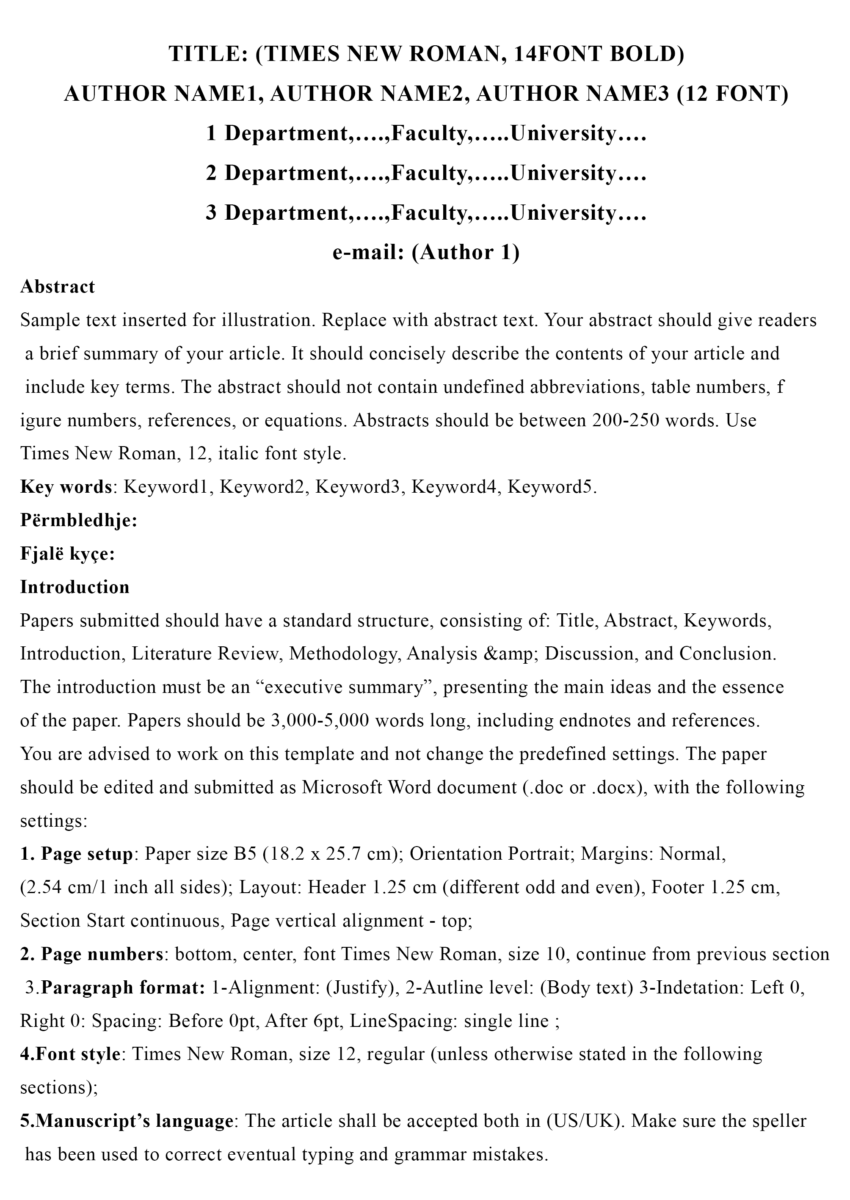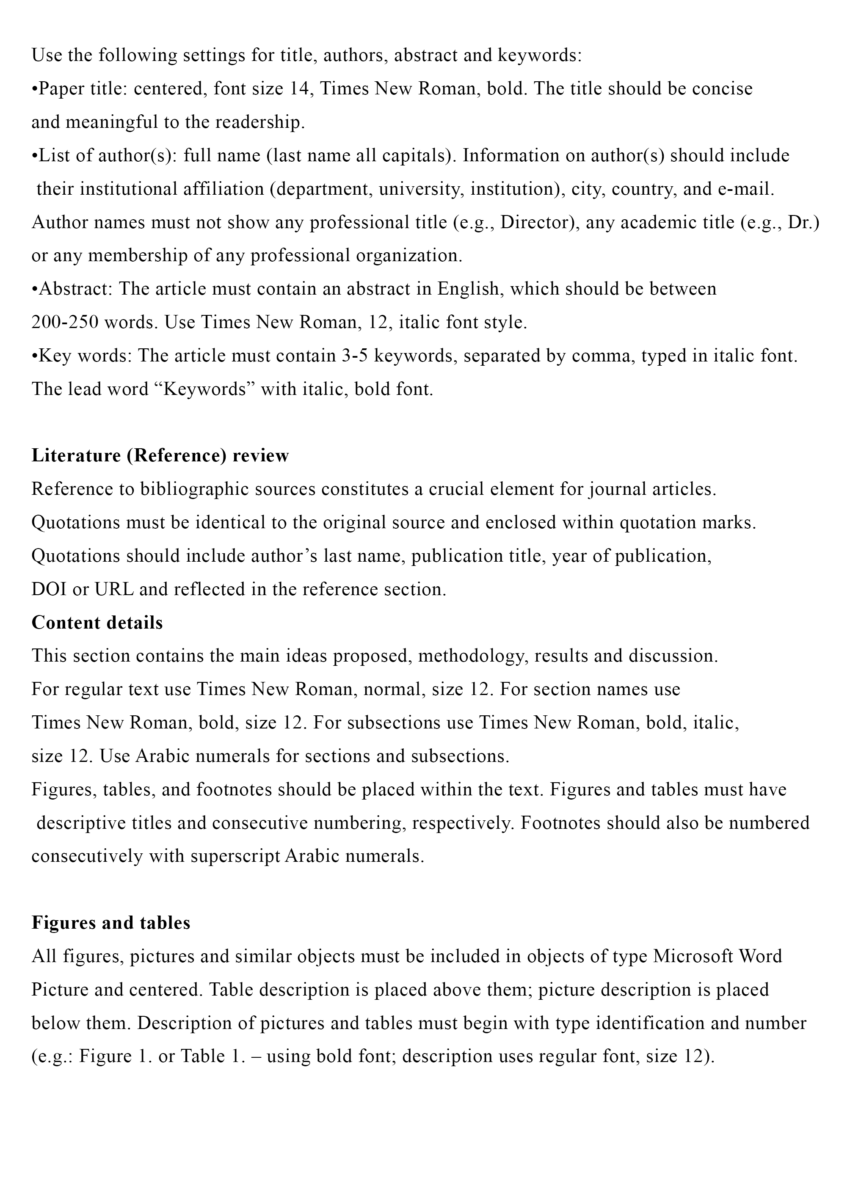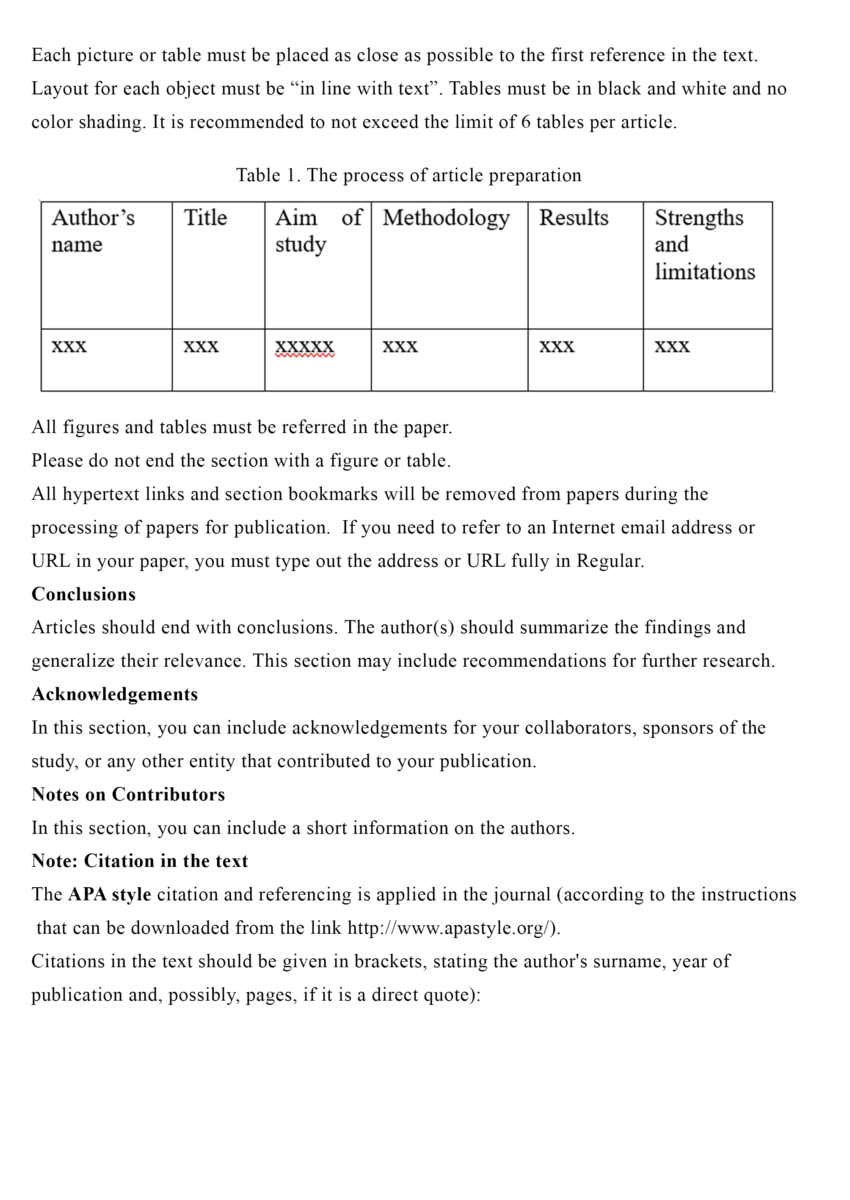



TITLE: (TIMES NEW ROMAN, 14FONT BOLD)
AUTHOR NAME1, AUTHOR NAME2, AUTHOR NAME3 (12 FONT)
1Department,….,Faculty,…..University….
2Department,….,Faculty,…..University….
3Department,….,Faculty,…..University….
e-mail: (Author 1)
Abstract
Sample text inserted for illustration. Replace with abstract text. Your abstract should give readers a brief summary of your article. It should concisely describe the contents of your article and include key terms. The abstract should not contain undefined abbreviations, table numbers, figure numbers, references, or equations. Abstracts should be between 200-250 words. Use Times New Roman, 12, italic font style.
Key words: Keyword1, Keyword2, Keyword3, Keyword4, Keyword5.
Përmbledhje:
Fjalë kyçe:
Introduction
Papers submitted should have a standard structure, consisting of: Title, Abstract, Keywords, Introduction, Literature Review, Methodology, Analysis & Discussion, and Conclusion. The introduction must be an “executive summary”, presenting the main ideas and the essence of the paper. Papers should be 3,000-5,000 words long, including endnotes and references.
You are advised to work on this template and not change the predefined settings. The paper should be edited and submitted as Microsoft Word document (.doc or .docx), with the following settings:
- Page setup: Paper size B5 (18.2 x 25.7 cm); Orientation Portrait; Margins: Normal, (2.54 cm/1 inch all sides); Layout: Header 1.25 cm (different odd and even), Footer 1.25 cm, Section Start continuous, Page vertical alignment – top;
- Page numbers: bottom, center, font Times New Roman, size 10, continue from previous section;
- Paragraph format: 1-Alignment: (Justify), 2-Autline level: (Body text) 3-Indetation: Left 0, Right 0: Spacing: Before 0pt, After 6pt, Line Spacing: single line ;
- Font style: Times New Roman, size 12, regular (unless otherwise stated in the following sections);Manuscript’s language: The article shall be accepted both in English (US/UK). Make sure the speller has been used to correct eventual typing and grammar mistakes.
Literature (Reference) review
Reference to bibliographic sources constitutes a crucial element for journal articles.
Quotations must be identical to the original source and enclosed within quotation marks. Quotations should include author’s last name, publication title, year of publication, DOI or URL and reflected in the reference section.
Content details
Content details
This section contains the main ideas proposed, methodology, results and discussion.
For regular text use Times New Roman, normal, size 12. For section names use Times New Roman, bold, size 12. For subsections use Times New Roman, bold, italic, size 12. Use Arabic numerals for sections and subsections.
Figures, tables, and footnotes should be placed within the text. Figures and tables must have descriptive titles and consecutive numbering, respectively. Footnotes should also be numbered consecutively with superscript Arabic numerals.
Figures and tables
All figures, pictures and similar objects must be included in objects of type Microsoft Word Picture and centered. Table description is placed above them; picture description is placed below them. Description of pictures and tables must begin with type identification and number (e.g.: Figure 1. or Table 1. – using bold font; description uses regular font, size 12). Each picture or table must be placed as close as possible to the first reference in the text. Layout for each object must be “in line with text”. Tables must be in black and white and no color shading. It is recommended to not exceed the limit of 6 tables per article.
Author’s name | Title | Aim of study | Methodology | Results | Strengths and limitations |
xxx | xxx | xxxxx | xxx | xxx | xxx |
Table 1. The process of article preparation
All figures and tables must be referred in the paper.
Please do not end the section with a figure or table.
All hypertext links and section bookmarks will be removed from papers during the processing of papers for publication. If you need to refer to an Internet email address or URL in your paper, you must type out the address or URL fully in Regular.
Conclusions
Articles should end with conclusions. The author(s) should summarize the findings and generalize their relevance. This section may include recommendations for further research.
Acknowledgements
In this section, you can include acknowledgements for your collaborators, sponsors of the study, or any other entity that contributed to your publication.
Notes on Contributors
In this section, you can include a short information on the authors.
Note: Citation in the text
The APA style citation and referencing is applied in the journal (according to the instructions that can be downloaded from the link http://www.apastyle.org/).
Citations in the text should be given in brackets, stating the author’s surname, year of publication and, possibly, pages, if it is a direct quote):
- in the case of summary or paraphrase, references should appear in brackets with the author’s name, followed by the year (Brandon, 2015), or (Smith & White, 2022) or in the case of multiple authors (Beckman et al., 2017);
- if the author is not known, give the title of the work and the year (Climate Change, 2020);
- if the same author has published more than two papers at the same year, then the papers are alphabetically separated, i.e. (Hall, 2018a; 2018b);
- in the case of quotation, add the page number, i.e. (Sam, 2019, p. 10);
- if the reference is within the body of the clause, give the author’s name and only the year of the paper in brackets, i.e. In Smith (2001) it is proposed
References
References should follow the APA Style convention, in alphabetical order at the end of the paper. If a referenced paper has multiple authors, they all should be quoted. Use Times New Roman, size 10 for references. Wherever possible, provide the DOI number, too, in addition to other reference data.
Please, check the examples:
D. Sarunyagate, Ed., Lasers. New York: McGraw-Hill, 1996.
G. O. Young, “Synthetic structure of industrial plastics,” in Plastics, 2nd ed., vol. 3, J. Peters, Ed. New York: McGraw-Hill, 1964, pp. 15-64.
G. Liu, K. Y. Lee, and H. F. Jordan, “TDM and TWDM de Bruijn networks and shufflenets for optical communications,” IEEE Trans. Comp., vol. 46, pp. 695-701, June 1997.
L. Bass, P. Clements, and R. Kazman, Software Architecture in Practice, 2nd ed. Reading, MA: Addison Wesley, 2003. [E-book] Available: Safari e-book.
